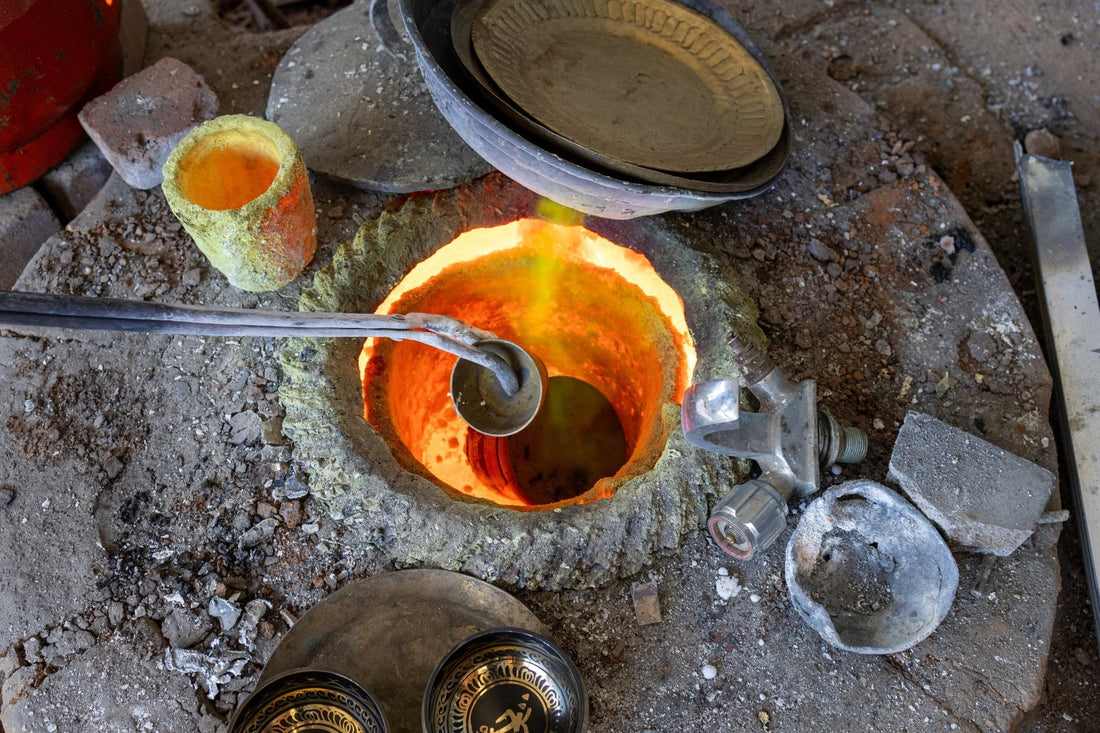
How Tibetan singing bowls are made
Singing bowls are powerful tools used for meditation, sound healing, and spiritual practices. Their soothing tones and vibrations promote relaxation and mindfulness. The craftsmanship behind each bowl—whether hand-hammered using traditional techniques or machine-made with modern methods—determines its unique sound and character. In this post, we’ll explore the process of creating these beautiful instruments, their cultural significance, and how they bring harmony to both body and mind.
Materials needed for making a singing bowl
The materials used in crafting a singing bowl play a critical role in determining its sound quality, resonance, and cultural authenticity. Each singing bowl is a blend of carefully selected metals, combined to create a harmonious balance of tone and durability. Here’s an overview of the essential materials and their significance:
Common metal components
- Copper: The primary material for its malleability and durability.
- Tin and zinc: Enhance resonance and protect against corrosion.
- Iron: Adds strength and unique tonal qualities.
- Gold and silver: Often included in ceremonial or high-end bowls for their symbolic and spiritual significance.
Seven-metal composition
Traditional singing bowls may blend seven sacred metals: Gold, Silver, Mercury, Copper, Iron, Tin, and Lead, which symbolise celestial bodies like the Sun, Moon, and planets. This composition produces complex, rich tones, ideal for spiritual practices.
Material variations
- Bronze bowls: Made from Copper and Tin, these bowls are durable and produce consistent, clear tones.
- Seven-metal bowls: Incorporating all seven metals, these bowls offer intricate, layered tones and are highly valued for meditation and healing.
Step 1: Shaping the metal
The first step in crafting a singing bowl involves shaping raw metals into a workable form, beginning with melting materials like Copper, Tin, and Zinc at high temperatures. The molten metal is poured into moulds, known as gulli cups, to define the bowl’s base size and weight. Once cooled, the moulds are processed into flat metal sheets of precise thickness, rolled, measured, and categorised to ensure consistency in size, weight, and sound quality.

Step 2: Hammering and annealing
Once the metal sheets have been prepared, the process of shaping the singing bowl begins through hammering and annealing (reheating). This step is labour-intensive and requires precision, teamwork, and the expertise of skilled artisans.
This involves heating metal sheets to a red-hot state for flexibility, layering 4–5 sheets, and shaping them through simultaneous hammering by a team of artisans. This is done in multiple cycles, as the metal must stay hot to avoid hardening and cracking. Between cycles, the metal is annealed to maintain malleability, ensuring durability and enhancing the bowl’s tonal quality.
The result is a bowl with slight variations in size, shape, and texture—hallmarks of its authenticity and craftsmanship. These differences add charm and uniqueness, appealing to those who value rich, complex tones and traditional artistry

Step 3: Tuning and shaping the bowl
After the initial hammering, the singing bowl is refined and tuned to perfect its shape and sound. Artisans place the rough bowl on a form or anvil, using additional hammering to smooth edges and achieve a uniform appearance. The tuning process involves striking the bowl to test its resonance and pitch, with adjustments made by reshaping or thinning specific areas to produce balanced, rich tones and harmonic overtones
Step 4: Applying designs and decorative elements
Once the bowl has been shaped and tuned, artisans move on to the decorative phase, adding intricate designs and embellishments.
Many singing bowls feature hand-etched or engraved patterns, such as mandalas, sacred geometry, or spiritual symbols like the Om mantra such as our Buddha Eyes Singing Bowl. These designs often carry cultural and spiritual significance, connecting the bowl to its traditional roots.
Some bowls are decorated using acid etching, a process that creates more precise and intricate patterns. This method is often used on machine-made bowls to achieve a polished, symmetrical look. While, high-end or ceremonial bowls may include custom designs or inscriptions, often using precious metals like Gold or Silver.

Step 5: Final polishing and finishing touches
The final step in crafting a singing bowl involves sanding and polishing to remove imperfections and create a smooth, shiny finish that highlights the metal’s composition. For decorative bowls, polishing enhances intricate designs by creating contrast between etched patterns and smooth surfaces, with some bowls receiving a matte or antique finish for a traditional look. Each bowl undergoes a thorough quality control process, including a final inspection and sound test to ensure it meets standards for resonance, durability, and quality.

Traditional techniques vs modern methods
Singing bowls are crafted using either traditional hand-hammered techniques or modern machine-made methods, each offering distinct benefits.
Hand-hammered bowls are shaped by skilled artisans through a labour-intensive process, resulting in unique, irregular designs and rich, layered overtones. These bowls carry cultural authenticity and are prized for their deep, resonant sound, ideal for meditation and sound healing.
Machine-made bowls, created with modern casting techniques, offer consistency in size, shape, and appearance. Their clear, even tones and polished finish make them accessible and appealing to beginners or those prioritising uniformity.
While hand-hammered bowls emphasise artistry and tradition, machine-made bowls focus on practicality and affordability, catering to a wide range of preferences and needs.
Variations in the process among different cultures
The process of crafting singing bowls varies across cultures, reflecting the unique traditions and artistry of each region. Nepal, Tibet, and India are renowned for their distinct approaches, each contributing to the diversity and richness of these instruments.
In Nepal, the art of hand-hammering bowls has deep cultural roots. Artisans often use the seven-metal composition, symbolising celestial bodies, to create bowls with intricate designs and rich, complex tones. The process is highly traditional, relying on skilled teams of artisans to shape and tune the bowls.
In Tibet, singing bowls are often associated with spiritual and monastic practices. Tibetan bowls typically feature simple designs but are valued for their profound resonance and meditative qualities. The crafting process is meticulous, with a focus on achieving precise tonal frequencies for spiritual use.
Indian singing bowls, while similar in craftsmanship, often emphasise decorative elements such as intricate etchings and symbols. These bowls may incorporate modern casting techniques alongside traditional methods, blending aesthetic appeal with functional sound quality.
Find your perfect singing bowl for sound healing and meditation
As a leading meditation store, Mindful Store takes pride in offering a curated collection of authentic singing bowls that celebrate traditional craftsmanship and elevate your sound healing or meditation practice. Each bowl is thoughtfully selected for its exceptional quality, unique design, and resonant tones, making it a meaningful addition for beginners and seasoned practitioners alike. Let us help you find the perfect singing bowl to enhance your mindfulness journey and connect with the transformative power of sound.
